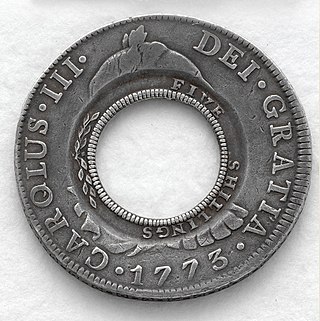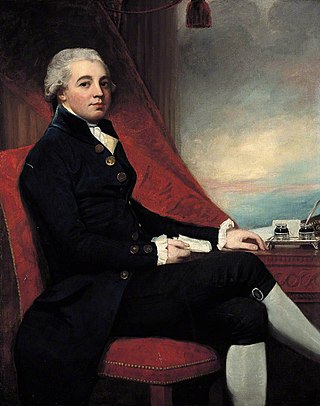
Lira is the name of several currency units. It is the current currency of Turkey and also the local name of the currencies of Lebanon and of Syria. It is also the name of several former currencies, including those of Italy, Malta and Israel. The term originates from the value of a Roman pound of high purity silver. The libra was the basis of the monetary system of the Roman Empire. When Europe resumed a monetary system, during the Carolingian Empire, the Roman system was adopted. The Roman denominations librae, solidi, denarii were used.

The Spanish dollar, also known as the piece of eight, is a silver coin of approximately 38 mm (1.5 in) diameter worth eight Spanish reales. It was minted in the Spanish Empire following a monetary reform in 1497 with content 25.563 g (0.8219 ozt) fine silver. It was widely used as the first international currency because of its uniformity in standard and milling characteristics. Some countries countermarked the Spanish dollar so it could be used as their local currency.

Holey dollar is the name given to coins used in the early history of two British settlements: Prince Edward Island and New South Wales. The middle was punched out of Spanish dollars, creating two parts: a small coin, known as a "dump" in Australia, and a "holey dollar". This was one of the first coins struck in Australia.

The rigsdaler was the name of several currencies used in Denmark until 1875. The similarly named Reichsthaler, riksdaler and rijksdaalder were used in Germany and Austria-Hungary, Sweden and the Netherlands, respectively. These currencies were often anglicized as rix-dollar or rixdollar.
The livre was the currency of Haiti until 1813. The Haitian livre was a French colonial currency, distinguished by the use, in part, of Spanish coins. It was equal to the French livre and was subdivided into 20 sous, each of 12 deniers. The escalin of 15 sous was also used as a denomination, since it was equal to the Spanish colonial real. Coins specifically for use in Haiti were issued between 1802 and 1809, along with various overstamped coins.
The real was the currency of Paraguay until 1856. Initially, the Spanish colonial real circulated. This was followed, in 1813, by the Argentine real. In 1845, Paraguay began issuing its own reales. Sixteen silver reales equaled one gold escudo. In 1856, the Paraguayan peso was introduced, worth 8 reales. The real continued to circulate as the subdivision of the peso until 1870, when Paraguay decimalized.
The Thaler was the currency of the Electorate, later Kingdom of Hanover until 1857. It was identical to the North German thaler except from 1754 to 1834 when it was worth 1/12 a Cologne Mark of fine silver. It was subdivided into 36 Mariengroschen, each of 8 Pfennig.
The thaler was a currency of the Kingdom of Westphalia between 1807 and 1813. From 1808, it circulated alongside the frank. The thaler was equal to those of the preceding states, including the Hannovarian thaler. It was subdivided into 36 Mariengroschen, each of 8 Pfennig.
The North German thaler was the currency of the Landgravate, then Electorate of Hesse-Kassel until 1858. Until 1807, the Thaler was subdivided into 32 Albus, each of 12 Heller. It was worth 3⁄4th a Conventionsthaler from 1754 to 1841.

The Assembly of Year XIII was a meeting called by the Second Triumvirate governing the young republic of the United Provinces of the Río de la Plata in October 1812.

Thomas Raikes was a British merchant particularly trading from London with Russia, a banker and newspaper proprietor. Notably, he was Governor of the Bank of England during the 1797 currency crisis, when the Bank was prohibited by the British Government from paying out in gold.

The rigsdaler specie was a unit of silver currency used in Norway from 1544, renamed as the speciedaler in 1816 and used until 1873. Norway used a common reichsthaler currency system shared with Denmark, Hamburg and Schleswig-Holstein until 1873 when the gold standard was implemented in Scandinavia and the German Empire.
The livre was the currency of Saint Lucia until 1814. The Saint Lucia livre was a French colonial currency, distinguished by the use of various cut Spanish and Spanish colonial coins. The livre was subdivided into 20 sous, each of 12 deniers. The escalin was worth 15 sous, with the stampee worth 3 sous, 9 denier. Until 1813, 12 escalins were equal to 8 reales, after which 15 escalins equaled 8 reales. In 1851, sterling was introduced for circulation.
The Geneva thaler was a coin equivalent to the French silver écu, containing 26.67 g fine silver and valued at 123⁄4florins, which was issued by Geneva until 1798 and between 1813 and 1839.

The Ticinese franco was the currency of the Swiss canton of Ticino between 1813 and 1850. It was subdivided into 20 soldi, each of 12 denari, similar to the British pounds, shillings and pence system. It was worth 1⁄4th the French silver écu or 6.67 g fine silver.
The livre was the currency of Guadeloupe until 1816. It was subdivided into 20 sous, each of 12 deniers, with the escalin worth 15 sous. The Guadeloupe livre was a French colonial currency, distinguished by the use, in part, of Spanish coins.

The pound was the currency of Nova Scotia until 1860. It was subdivided into 20 shillings, each of 12 pence. It was equivalent to sterling and was replaced by the dollar in 1860, at a rate of $5 = £1, although coins and notes of the dollar currency were not issued until 1861.
The pound was the currency of Prince Edward Island until 1871. It was divided into 20 shillings, each of 12 pence. It was replaced by the dollar in 1871. Initially sterling coin circulated, together with locally produced coins and paper money.

The Danish state bankruptcy of 1813 was a domestic economic crisis that began in January 1813 and had consequential effects until 1818. As Denmark–Norway struggled with the financial burden that the Napoleonic Wars had on the economy, the devaluation of the currency had negative effects on merchants, citizens and businesses alike.

Radhanpur State was a kingdom and later princely state in India during the British Raj. Its rulers belonged to a family of Babi House, the state was once a polity within the Mughal Empire. The last ruling Nawab of Radhanpur, Nawab Murtaza Khan, signed the instrument of accession to the Indian Union on 10 June 1948.











